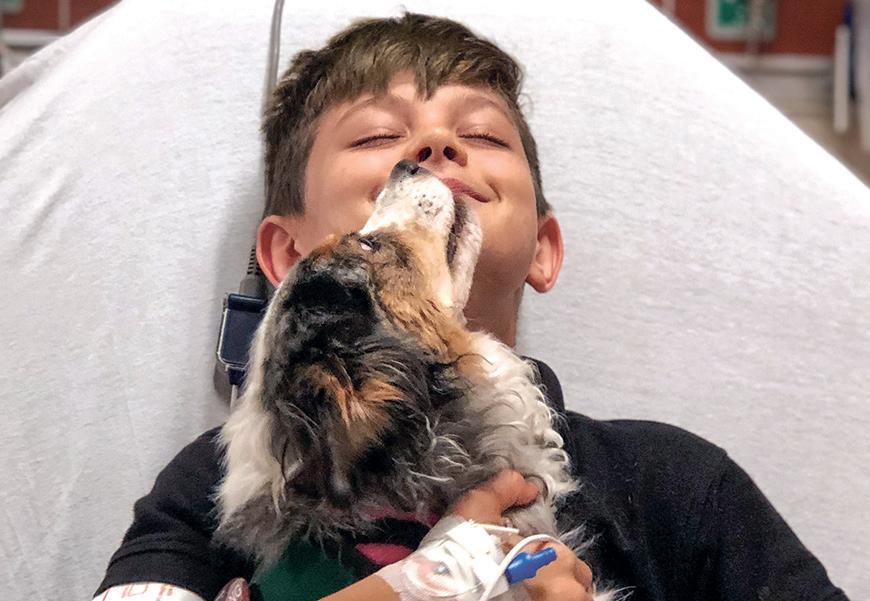
3 minute read
Stay at least 40 feet away from all power lines and call 911 immedi ately. The ground can be energized up to 35 feet away or through any water that is in contact with a downed line
Schneider, a licensed social worker, has worked as a therapist since 1986. She founded Healing Through Horses in 2007 to inspire wellness through the power of the equine spirit. Schneider says horses can help those who have PTSD because the animals are wellgrounded and tune in quickly to what is going on with a person.
Schneider gave an example of how she might work with a woman with PTSD, who was feeling overwhelmed. She might have the woman walk in the corral among the horses. As her heart rate drops and becomes calm, the horses may feel safe enough to approach, positively reinforcing the woman’s behavior.
For someone showing signs of distress, Schneider might guide the person to place their hands on one of the horses.
“Eventually, they will come back to themselves because they have contact,” Schneider says.
For some people, the size of the horses and their power can be frightening, even terrifying. Schneider told a story of a young girl in foster care who came to see her for therapy. The girl had been hurt by the adults in her family of origin. The horses were another large, ominous presence to her. The girl was so frightened of the horses she expressed anxiety whenever she came near one.
“She thought anything bigger than her was going to kill her,” says Schneider. “Eventually, she learned that big people—adults—are not all dangerous. But she only learned that through the horse. That was what we worked on for a long time. Touch the horse, and you survive. Brush the horse, and he likes you, he doesn’t move away, he’s not going to hurt you. For her, that was
A woman asking for guidance at Healing Through Horses. monumental.” Eventually, the girl was able to get up on the horse.
“It was a surrendering,” says Schneider. “She surrendered to the fear of death. She learned that trusting something is okay.” The girl not only conquered her fear but she also made friends. The horses would follow her around, says Schneider. They became her companions and confidants.
Canines to the Rescue
Across the country, another woman is immersed in the healing power of dogs. For 25 years, Marni Bellavia has worked with the Humane Society of Broward County in Florida. Her title is the Manager of Animal Assisted Therapy, and she trains volunteers and their companion animals to provide comfort to those in need of extra support. The program serves three counties and helps people in hospitals, hospice settings, senior retirement homes, mental health care facilities, children’s facilities, foster homes, group homes, libraries, and schools.
On Valentine’s Day 2018, Bellavia heard the news of the shooting at Marjory Stoneman Douglas High School that took place in Parkland, only 30 minutes away. She sprang into action. The very next day, she had dog-and-person teams deployed to the high school as well as nearby schools where they could offer support for students, faculty and families. Throughout the year, 20 teams attended community vigils, visited people at their homes, came to school, and continued to be a resource for those affected by the shooting.
There was a profound loss of hope, says Bellavia. “Most of the kids, honestly, didn’t want to talk to anybody. I mean, it was horrific,” Bellavia emphasizes.
Working with the counselors and psychologists at the school, Bellavia and her teams took the dogs to therapy sessions. With the animals present, students were able to cry and talk to the animals about what had happened and how they felt. The dogs worked with students individually and sometimes with groups.
“The animals were providing comfort and that unconditional love and nonjudgment that you don’t normally get from people,” Bellavia explains.
Though Bellavia responded to the school shooting by making her dogand-person teams available to others, she was working in new territory. It made her realize there was not yet an animal-based trauma-response effort that could serve her community. She knew that needed to change.
On a sleepless night, about two weeks after the shooting, Bellavia came up with the idea for the Canine Community Resilience program. The new program provides canine sup-







